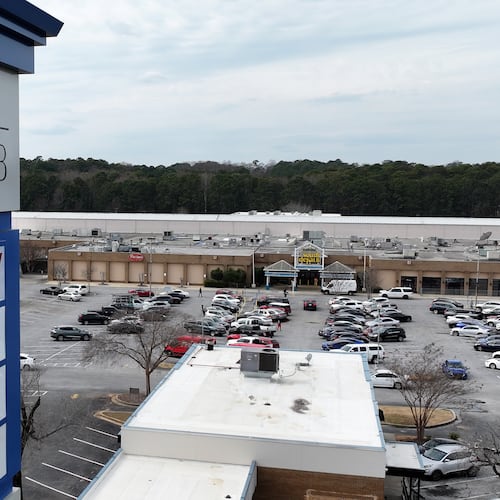The damage is done. But the cleanup, repairs and rebuilding are just beginning for South Georgia, and it won’t be a speedy process.
Tropical Storm Michael swept out of Georgia before sunrise Thursday, leaving a trail of destruction in its wake. The powerful storm claimed the life of an 11-year-old girl in southwest Georgia, which appeared to have borne the brunt of Michael's wrath. Utility crews around the state scrambled to restore power to more than 300,000 customers.
Farmers surveyed their destroyed crops, now valued at $1 billion, and many say it will also cost them their livelihoods. At least 53 poultry houses were wiped out in Coffee, Houston, Mitchell, Wilcox and Decatur counties, officials said.
The cotton was muddy and the people were tired Thursday in extreme southwest Georgia.
Scott Sumerlin, 22, went around the corner from his trailer to the Michael’s shop Thursday afternoon. The gas station was running pumps on a generator, and Summerlin waited 15 minutes to fill up about 20 gallons of fuel. He rode out the storm in his father’s brick home.
“I ain’t never seen anything like that,” he said.
Michael charged into Georgia Wednesday night, packing 115 mph winds. It was the first Category 3 hurricane, to make a direct hit on the state in more than a century, according to Channel 2 Action News meteorologist Brad Nitz.
The storm weakened as it churned in a northeast arc through the state’s largely rural midsection, downing trees and power lines in its path.
By Friday evening, the storm that began as Hurricane Michael was blamed for at least 16 deaths across the Southeast.
President Donald Trump declared a federal state of emergency in Georgia counties affected by the storm, a measure that makes emergency funds available, and is expected to visit the area next week. Gov. Nathan Deal encouraged him to come see the damage for himself.
“It is still very early in the process, and many of the agencies are still in the assessment stage,” Deal said Thursday. He urged residents to be patient and to let repair crews begin their work.
Health and Human Services Secretary Alex Azar also declared a public health emergency in Georgia due to the storm.
“We are working closely with state health authorities and private sector partners from hospitals and other healthcare facilities to save lives and protect public health after Hurricane Michael,” Azar said said in a press release. “This declaration will help ensure that our fellow Americans who rely on Medicare and Medicaid have continuous access to the care they need.”
Clearing roads, removing debris
Georgia Department of Transportation crews were working to clear at least 127 incidents where state routes were blocked. Interstate highways are clear, but it could be several days before all state routes in southern Georgia are open, a spokeswoman said.
GDOT inspected and reopened all bridges on state highways and removed debris from many roads. But the department still faced nearly 90 road closures caused by downed trees and other debris. And 189 traffic signals remained down across the Peach State.
Catherine Howden, chief of staff for the Georgia Emergency Management and Homeland Security Agency, said southwest Georgia was facing myriad problems.
As of Thursday evening, 12 hospitals and 26 nursing homes were operating on generators. GDOT forces, which had completed clearing all interstates with help from state prisoners and forestry workers, were beginning to focus on secondary routes in the southwest region. About 600 Georgia National Guard troops were on the ground helping with various tasks.
State emergency workers were in talks with cell phone service providers to figure out when towers that went offline would come back.
“We’re still hearing a lot of communications issues,” she said.
But the images, and stories from survivors, told the story. A spokeswoman for the Georgia Chapter of the American Red Cross said 90 shelters were open Wednesday in Georgia, Alabama and Florida, and that number could rise as people returned to what remained of their homes and find they can’t stay.
In Seminole County, 11-year-old Sarah Radney became the state's first — and so far the only — known casualty of the storm. County authorities said the child died after a tree crashed into her home.
In Albany, the storm left 100 intersections blocked, 24,720 customers without power, trees toppled on houses, siding wrapped around light poles, and the glass blown out of the downtown convention center.
“It represented an unprecedented amount of damage,” Dougherty County Commission Chairman Chris Cohilas said at a press conference.
A National Guard Unit was deployed to the area. So were 45 lineman crews and 18 more tree-cutting crews.
“The damage to our infrastructure is phenomenal,” Cohilas said. Despite the destruction, officials in Dougherty County have no reports of fatalities.
Terrance Davis, who has lived in Albany all his 25 years, rode out the storm at home off Jefferson Street. He said his home lost power about 7 p.m. Wednesday. Trees covered most of the road in front of where he lives.
“These past few years are the worst,” he said, referring to the January 2017 tornadoes that tore up whole neighborhoods in Albany.
Roosters sounded off Thursday morning as neighbors on checked on each other.
Surveying the damage
Damage from the storm lessened as it moved further north through Georgia. Michael had lost much of its punch and was downgraded to a tropical storm by the time it arrived in Macon overnight, bringing wind gusts in excess of 50 mph.
The Middle Georgia city was left with widespread power outages, about three dozen downed trees and widespread relief that the worst had been avoided. Macon-Bibb Emergency Management Agency spokesman Chris Floyd feared Michael’s wrath would exceed Tropical Storm Irma last September, which left 100,000 cubic yards of debris in its wake, closing 229 roads.
“We won’t know the full extent of the damage for a little while,” Floyd said. A tornado touched down in Crawford County, about 35 miles southwest of Macon, leaving seven homes damaged. But there were no reported injuries.
Power crews swarmed neighborhoods throughout the day, cutting branches and clearing paths. By late Thursday afternoon, service had been restored to 234,000 Georgia Power customers, but the utility reported 117,000 customers remained without power.
In Bainbridge, Greg Merritt and his family sat in plastic lawn chairs, taking in the whole ordeal of recovery Thursday. The five of them spent the night of the storm cowered in their hallway, huddled underneath a mattress to protect themselves from the trees and falling debris.
“The limbs got slapping,” the 47-year-old said. “I never seen anything like this in Bainbridge.”
He said he has learned from his first hurricane and would ride out the next one in a hotel far away.
“I don’t want to go through this again.”
The Latest
Featured




